
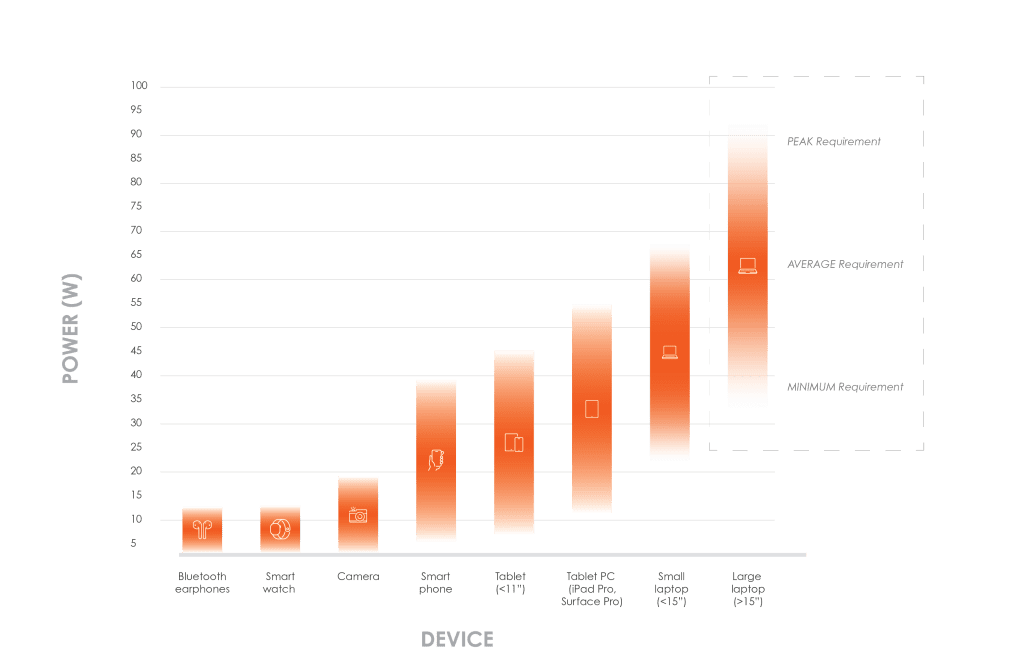
Portable technology has become an integral part of our daily lives, and it is continually advancing. At OE, we understand the importance of keeping your devices charged and ready to go at all times. That’s why we are always one step ahead with a compatible USB charger to power it.
At OE, we offer a wide range of USB chargers with varying specifications to meet the needs of different devices. Our USB chargers range from our 12W A+A TUF charger to high-powered 100W C+C chargers capable of charging multiple devices simultaneously. Whether you’re looking to charge your smartphone, tablet, laptop, or other portable devices, we have a USB charger that will suit your needs. Not only are TUFs designed for easy replacement, but they can also be replaced on-site without requiring an electrician. This means that if a TUF becomes damaged, it can be quickly and easily swapped out, reducing the need to replace the entire unit. This not only saves time and money, but it’s also an environmentally friendly solution, making TUFs a smart choice for those looking to reduce waste and minimize their carbon footprint.
When it comes to laptop charging, there are a few factors to consider. Some larger laptops can reach a peak power consumption of 90W during charging, but this typically occurs only for the initial 20–30 minutes while the battery is being charged from 50-70% capacity. After that, the power demand decreases.
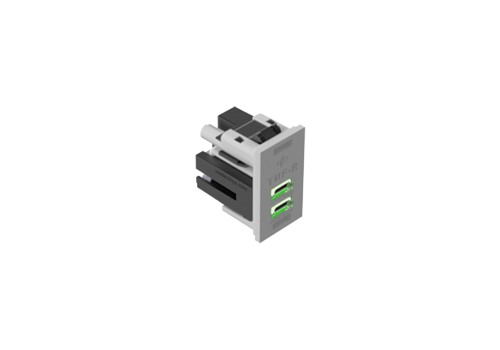
QF05 TUF HP C+C 72W∗
Two USB-C ports with a combined 72W output

QF05 TUF EP C+C 150W†
Two USB-C ports with a combined 150W output
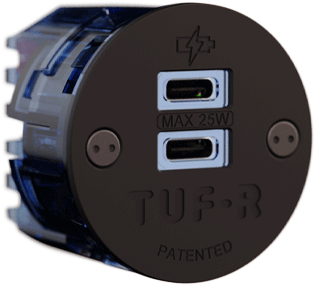
MAY 2024
TUF-R 30W C+C
Two USB-C ports with a combined 30W output
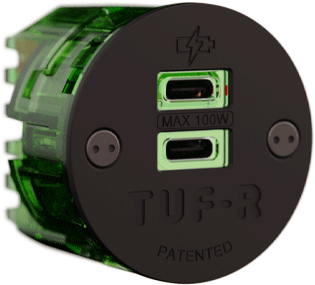
MARCH 2024
TUF-R EP C+C 72W∗
Two USB-C ports with a combined 72W output

MARCH 2024
TUF-R EP C+C 150W†
Two USB-C ports with a combined 150W output
∗ with canister or QF30 PSU
† with QIKPAC or 150W PSU (coming soon)
Certain laptops, such as MacBooks, tend to utilize the available power efficiently. They will draw as much power as is provided to them, whether it’s 25W or less, resulting in slower charging, or if their power consumption exceeds the power input, they may gradually lose charge. This behaviour differs from laptops like HPs, which usually require a charger with a power rating of at least 45W to charge when using third-party chargers like our TUF.
It’s important to note that you cannot extract more than 60W from a charger unless you have an Extended Power Range (EPR) Type-C USB cable. So, even if you have one of OE’s 100W TUF chargers, when using a standard USB cable, the maximum power you can get is limited to 60W.
Another aspect to consider is the average power usage of laptops during normal operation, which typically ranges from just 5 to 10W. This power requirement is relevant once the battery is fully charged, as it represents the amount of power needed to keep the laptop running and maintain a full charge. For example, the QIKPAC, with a capacity of 200Wh, can power a MacBook for approximately 28 hours (200Wh / 7W per hour = 28 hours). The 7W power usage figure is obtained from the Apple website.
To calculate the average power usage of a specific laptop, consult the manufacturer’s specifications by dividing the battery capacity in Wh by the quoted run-time.
The graph presented below provides an overview of the peak, average, and minimum power requirements for various typical devices. Due to the vast number of devices available in the market and the continuous release of new ones, it is impractical to include every device on the graph. Instead, this graph aims to provide a general estimate of the power needs for each device category.
Please note that the values depicted in the graph are approximate and can vary depending on specific models and configurations. It is always recommended to refer to the manufacturer’s specifications for precise power requirements of a particular device.
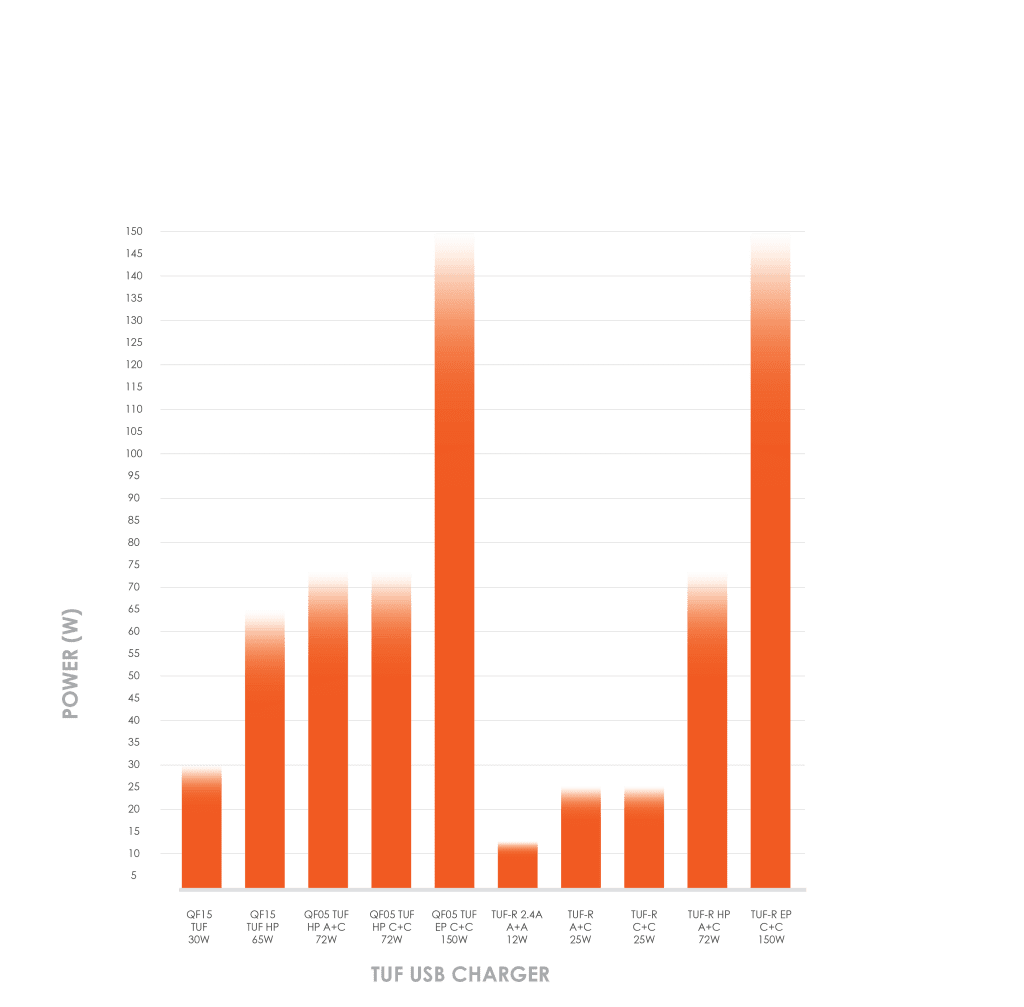
Since its initial release in 2011, OE has been dedicated to enhancing and expanding the TUF USB Charger line. Our relentless commitment to improvement and development has been driven by two primary factors: customer feedback and thorough market research. By attentively listening to the needs and desires of our customers, as well as pro-actively identifying emerging trends, we strive to incorporate innovative features into the TUF that anticipate and exceed market demands.
Over the years, each iteration of the TUF has undergone significant advancements based on customer input and insightful market analysis. Our aim is to stay ahead of the curve and introduce functionalities that cater to our customers’ requirements even before they realize they need them. By consistently pushing the boundaries of technological innovation, we have solidified our position as a leading provider of cutting-edge USB chargers. The graph below shows how much power each TUF is capable of delivering, so armed with the typical power consumption figures of your devices from the previous page, you can make an informed decision as to which TUF is right for you.
Don’t be shy, say hi
We are excited to hear about your ideas. Drop a line below and our expert team will be in touch.
| Cookie | Duration | Description |
|---|---|---|
| cookielawinfo-checkbox-analytics | 11 months | This cookie is set by GDPR Cookie Consent plugin. The cookie is used to store the user consent for the cookies in the category "Analytics". |
| cookielawinfo-checkbox-functional | 11 months | The cookie is set by GDPR cookie consent to record the user consent for the cookies in the category "Functional". |
| cookielawinfo-checkbox-necessary | 11 months | This cookie is set by GDPR Cookie Consent plugin. The cookies is used to store the user consent for the cookies in the category "Necessary". |
| cookielawinfo-checkbox-others | 11 months | This cookie is set by GDPR Cookie Consent plugin. The cookie is used to store the user consent for the cookies in the category "Other. |
| cookielawinfo-checkbox-performance | 11 months | This cookie is set by GDPR Cookie Consent plugin. The cookie is used to store the user consent for the cookies in the category "Performance". |
| viewed_cookie_policy | 11 months | The cookie is set by the GDPR Cookie Consent plugin and is used to store whether or not user has consented to the use of cookies. It does not store any personal data. |